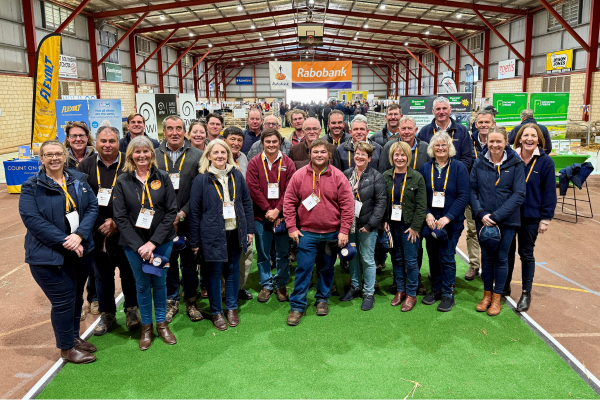Ten New Zealand farmers have recently returned from a week-long sheep and wool knowledge tour in Western Australia where they took in visits to several sheep and wool operations across the state’s highly-productive Great Southern region.
Running from August 10 to August 16, the knowledge tour provided attendees with insights into the unique role Western Australia plays in Australia’s agricultural landscape due to its geographical distance and export-orientated market.
Operations visited included the Australian Wool Exchange in Bibra Lake, Peel Feedlot in Mardella, Hillcroft Farms near Narrogin, Elders Wool Store in Rockingham and Yarranabee Pastoral in Highbury.
The Kiwi participants – farming couples Ele and Grant Ludemann from North Otago, Nelson and Fiona Hancox from West Otago, Murray and Ruby Baird from Southland, Alex and Sarah Kyle from the Wairarapa, and father and son Whatarangi Murphy-Peehi and Whatarangi Biel-Peehi from Tangiwai – were joined in the 27-strong tour party by 11 Australian-based farmers and several Rabobank staff including New Zealand-based RaboResearch senior analyst Jen Corkran.

Western Australia Sheep Expo and Ram Sale in Katanning
Ms Corkran said the Western Australian tour was the latest in a series of tours run by Rabobank in regions around the globe to share knowledge, expertise and international networks with clients.
“These tours give clients an opportunity to step away from their businesses, expose themselves to different thinking and insights, and learn and engage with their farming peers,” she said.
“The tour group bonded together really quickly and the even split of Kiwi and Aussie farmers ensured plenty of robust discussion.”
Ms Corkran said the Western Australian sheep sector has experienced significant change over recent years.
“Western Australia’s sheep industry is undergoing a major shift, driven by the phase-out of live export and evolving farm systems that must fit into the climatic environment,” she said.
“Sheep numbers are declining in Western Australia, with a noticeable move in some instances, away from wool breeds toward meat and shedding breeds. However, the Merino flock is still very much a part of the system.”
Ms Corkran said the tour highlighted the innovation, resilience and changes in strategic direction being demonstrated by farmers and others throughout Western Australia’s food and agri supply chain as they adapt to the transforming environment.
“Several of the New Zealand producers observed strong parallels between the current situation in Western Australia and their own challenges, especially around wool viability and flock reduction,” she said.
“And the New Zealand-based farmers and I were able to gain some valuable insights by comparing systems, questioning approaches and exploring new ideas.”
Lower Western Australian flock set to benefit New Zealand?
Tapanui-based farmers Nelson and Fiona Hancox said they’d signed up for the tour to find out more about what was happening in the Western Australian sheep sector and how this might impact their own operation.
“We wanted to understand more about what’s happening in Western Australia including any risks or potential upside for New Zealand lamb producers,” Mrs Hancox said.
“We also wanted to find out if there were opportunities for the New Zealand and Australia sheep industries to work closer together.”
The Hancox, who alongside family and staff run a sheep and beef operation comprised of 27,000 ewes and 500 Angus cows, said one of their key takeaways from the tour was the potential opportunity lower sheep numbers in Western Australia created for New Zealand producers.
“Their summer is like our (south island) winter, with nil growth. They are starting to grain feed, in feed-lots and grow finishing crops for lambs, to hold for the meat processors,” Mr Hancox said.
“The lamb numbers are dropping quickly with everyone increasing cropping area, even traditional sheep properties are expanding crop area.”
Off the back of what they had seen, Mrs Hancox said, the couple remained optimistic about the future prospects for New Zealand’s sheep industry.
“The tour helped reinforce that it’s just New Zealand and Australia competing for global sheep meat exports and, with Western Australian sheep numbers declining and a global shortage of lamb looming, we’re now looking at increasing our sheep number or kilograms of lamb meat sold per hectare,” she said.
Learning opportunity
North Otago-based Grant Ludemann – who alongside wife Ele owns EGL Pastoral Group, a large-scale farming business consisting of lamb finishing, breeding and dairy properties – said the couple had learnt “a heck of a lot” on the tour.
“It was a fantastic week, and a camaraderie quickly built up among the tour participants,” he said.
“The feed lotting was of great interest to me, and I enjoyed learning more about how they‘re incorporating this into their systems to help combat the Mediterranean-style weather climate.”
“I also found it really interesting how much of Australia’s lamb production is consumed locally. In New Zealand this figure is only about 5%, but in Australia it’s much higher at around 35%.”
In addition, Mr Ludemann said he found it useful learning about the different machinery being used on Western Australia farms.
“One of the farms we visited were using some lamb weighing scales that allow for real-time weight monitoring directly from the paddock,” he said.
“I haven’t seen this technology available in New Zealand before and I’m now investigating purchasing some of these scales for our own operation.”
